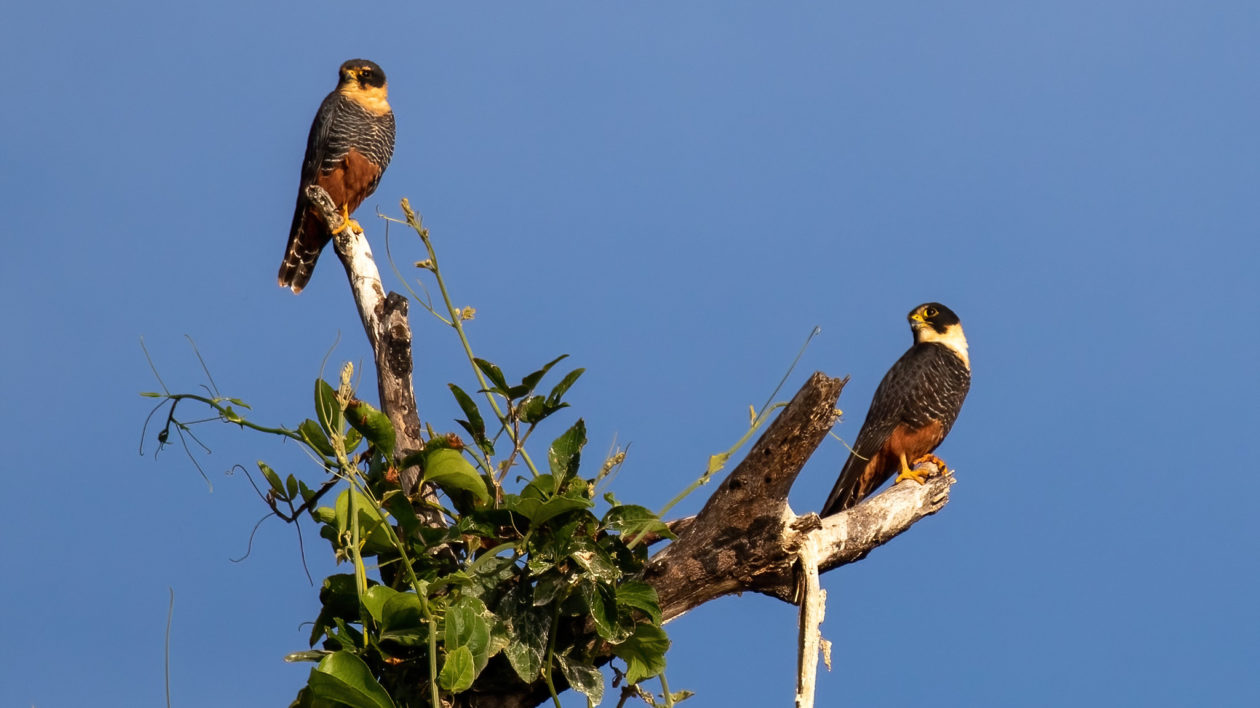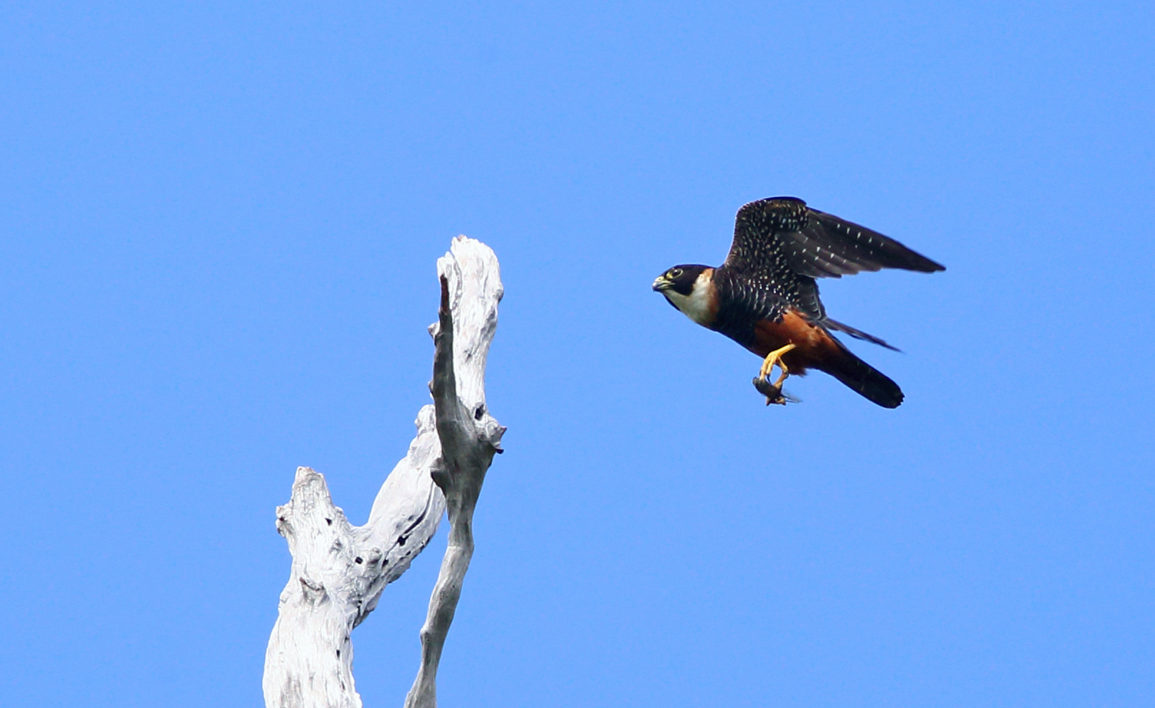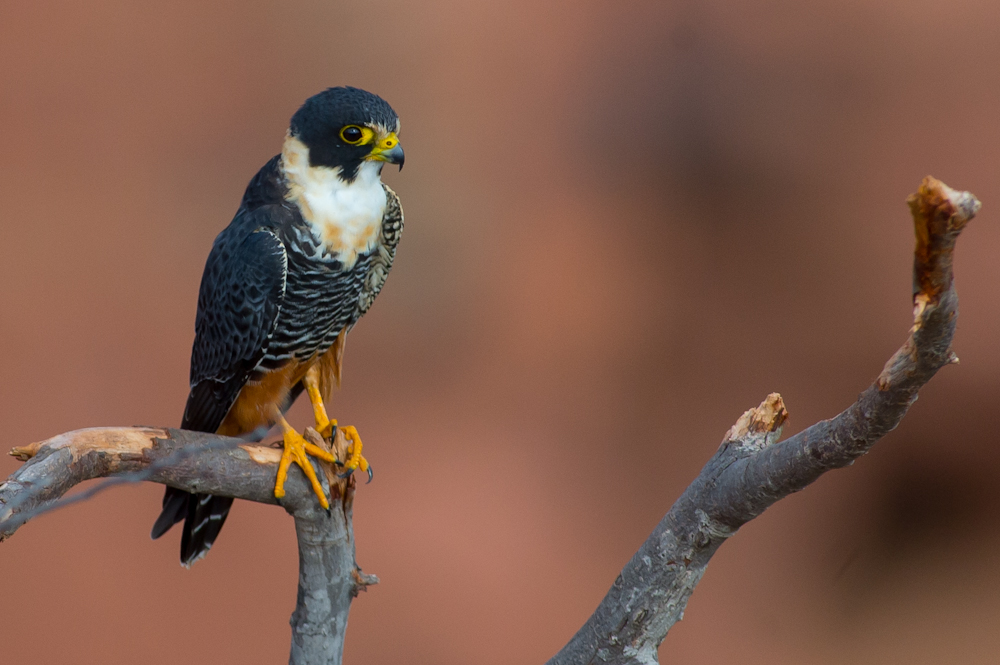Sometime in December 2021, a wayward bat falcon turned up in southern Texas.
First reported by Rebecca Gelernter on December 8th, in Santa Ana National Wildlife Refuge, the falcon caused a small sensation in the American birding community. Over the next few weeks, thousands of birders flocked to see the falcon, all eager to tick off a new species to their bird lists.
Earlier this month, the American Birding Association (ABA) officially added the bat falcon to the ABA Area Checklist. So let’s get to know the United States’ newest bird.
Checklist Redux
First, a quick recap on the ins and outs of the ABA Checklist.
The American Birding Association keeps the official record of bird species documented in the ABA Checklist Area, which includes the United States (including Hawaii), Canada, and waters up to 200 miles offshore. (Essentially, it’s anything north of Mexico, minus Bermuda, The Bahamas, and Greenland.)
Most of the 1,133 species on the ABA Checklist are species that regularly breed in or migrate through the ABA area. Every so often, a handful of new birds are added to the list. These are typically vagrants that have turned up on accident (like the bat falcon), introduced species with small breeding populations (like many species of feral parrot), or taxonomic splits, when an existing bird species is “split” into two species based on new science.
Before being added to the list, reported rarities are vetted by a committee of expert ornithologists to ensure that the species is correctly identified.
So why do these lists matter? First, the ABA Checklist acts as the official record of birds for the area, vetting and documenting rarity reports for posterity. Second, the checklist matters for the subset of birders who love to keeps lists, or those chasing a Big Year.
During a Big Year, a birder tries to see as many species as possible in a particular geographic area during a calendar year. You can do a Big Year in your backyard, your county, or in your state. But a small, hardcore group of birders go for a Big Year across the entire ABA Area, competing to see who can break the record.
And that’s where the ABA Checklist come in. Big Years are governed by a set of rules, and one of those rules is that you’re only allowed to count species on the official checklist. If you nab a new rarity, like the bat falcon, your sightings need to be officially vetted and accepted by the ABA before you can count them.
Meet the Bat Falcon
Now, back to the bat falcon.
This mega-rarity was one of 5 new species added to the ABA Checklist in August 2022. The other four species include 2 introduced parrots now breeding in the US; a Eurasian rarity, the rufous-tailed rock-thrush; and the Chihuahuan meadowlark, a new species recently split off of the eastern meadowlark.
Bat falcons (Falco rufigularis) are widespread in the Neotropics, inhabiting woodlands and forest clearings in the lowlands of Mexico, Central America, and northern South America.
Given that their range just nudges the US-Mexico border, it’s not a complete shock that an individual would end up in southern Texas. (It’s certainly not as weird as the wayward Steller’s sea eagle that’s still popping up around New England and eastern Canada, very far from its home in eastern Asia.)
But just because it wasn’t totally unexpected doesn’t mean it’s any less exciting.

At a quick glance, the bat falcon resembles a peregrine falcon. They have the same chunky falcon shape, yellow legs, grey plumage, a barred underbelly with a white chest, and dark head. Unlike the peregrine, bat falcons have rusty coloration around their legs and underbelly, often referred to as “trousers.” Similar species include the orange-bresated falcon and the aplomado falcon.
As you might have guessed, bat falcons are named for one of their (many) prey species: bats. Bat falcons consume bats, small birds (swifts, swallows, hummingbirds, parakeets), reptiles, amphibians, and insects. They’re crepuscular, meaning they’re most active at dawn and dusk, which is a convenient time to catch bats as they come to or from their daytime roosts. Like many birds of prey, male bat falcons are smaller than females, and so they typically take smaller prey, like insects. The larger females are more likely to kill and consume bats and birds.
Bat falcons are considered a species of Least Concern by the IUCN, although their populations are declining.

The Celebrity Falcon of Santa Ana
To the delight of birders, the bat falcon stayed in Santa Ana National Wildlife Refuge until early March. The bird, likely a juvenile male, helped birder Tiffany Kersten break the Big Year record for the Lower 48. By late December she had tied the previous record of 724 birds, and the bat falcon was #725. She ended the year with 726 species, after seeing a northern lapwing in New Jersey.
Even if you’re not doing a Big Year, the bat falcon is a timely reminder to keep your eyes peeled, especially if you’re birding on the fringes of the ABA Checklist Area.
You never know what could turn up.




The emphasis on “running up the score” of number of birds seen in a given year or month or weekend seems inspired more by personal vanity, competitiveness and bragging rights than by simple enjoyment of the natural world.
Some serious birders try to attach a veneer of altruism to the numbers pursuit, like with legitimate citizen science projects like the Christmas Bird Count, Feeder Watch, etc.
However, someone flying around the country or world to cram in as many birds as possible is not doing it for research. Like wealthy clients who climb Mt. Everest now, it is 100% vanity, 0% science.
I am not a focused birder, I’m well-rounded naturalist who enjoys observing and trying to identify every wildflower, tree, grass, shrub, weed, butterfly, moth, bee, wasp, other invertebrates, bird, reptile, mammal, cloud and bright star that I encounter. I do this because I’m fascinated by the world around me. When you can identify the fora and fauna around you, then you feel more at home in the world. I also became a fluent speaker in our local Native language (Nuwä or Kawaiisu) because that opened up more awareness of the natural world as well.
I keep no lists and don’t compete in any way. And every year is a Big Year for me.